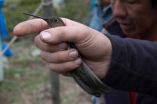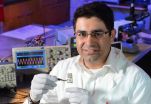(Press-News.org) Today we know that women carrying BCRA1 and BCRA2 gene mutations have a 43% to 88% risk of developing from breast cancer before the age of 70. Taking critical decisions such as opting for preventive surgery when the risk bracket is so wide is not easy. Spanish National Cancer Research Centre (CNIO) researchers are conducting a study that will contribute towards giving every woman far more precise data about her personal risk of suffering from cancer.
The paper has been authored by 200 researchers from 55 research groups from around the world and describes two new genes that influence the risk of women developing breast and ovarian cancer when they are carriers of BCRA1 and BCRA2 mutations.
According to Ana Osorio, lead author of the study and a researcher in the Human Genetics Group, at CNIO: "The aim is to create a test that includes all known genetic variants that affect the risk of developing cancer, and at what age, in order to be able to compile a personalised profile for each patient." Osorio and Javier Benitez, the Director of the CNIO's Human Cancer Genetics Programme, have jointly coordinated the work of all the participants in the study.
The finding is part of an international effort by the scientific community to get a more precise understanding of genomic information. Researchers are trying to identify genes associated with cancer as well as the reasons why the same mutated gene affects different people in different ways.
In the specific case of BRCA1 and BRCA2 genes, malfunctions may be caused by thousands of different mutations. However, the effects of these mutations can depend on other DNA variants found in other genes. These DNA variants may be caused by a single change in a chemical component from the 3 billion that make up the human genome. These single changes, known as SNPs (Single-nucleotide polymorphisms), do not inactivate genes and nor are they pathological in and of themselves, but they can play an important role when high-risk mutations already exist.
Understanding the genome to this degree of detail demands a lot of work. The weight of each risk-modulating element is small, so thousands of samples are needed for the effect to show in the data.
To do the work for the study that has been published, the researchers created a consortium called CIMBA (The Consortium of Investigators of Modifiers of BRCA1/2) in 2006, made up of research groups from around the world. CIMBA, with data from more than 40,000 carriers of BRCA1 and BRCA2 mutations, has the largest number of samples from which mutation interactions with SNPs can be studied.
Up to now, CIMBA has managed to associate more than 25 SNPs with the risk of developing breast or ovarian cancer in carriers of BRCA1/2 mutations. The study led by CNIO researchers adds at least two more to the list.
To find them, the study's authors worked in two phases: they first analysed samples from 1,787 Spanish and Italian carriers of BRCA1/2 mutations, and managed to identify 36 potentially interesting SNPs; they later investigated their importance in a further 23,463 CIMBA samples. They thus discovered 11 SNPs that indicate risk, especially so in the case of two of them. Their influence is small—the largest risk multiplier is just 1.12—which is to say 12% on the base risk.
As Osorio explains: "The weight of each of these SNPs is very small, but with the 27 already described, the risk might increase or decrease for a woman who is a carrier of mutations."
KNOWING WHERE TO LOOK
The newly discovered SNPs are in two genes known as NEIL2 and OGG1, and not by chance. The researchers went straight to the place where they found them. This way of working distinguishes this study from others that look for BRCA1/2 risk modulators by brute force: analysing and comparing everything to everything.
What advantages does searching with a compass offer? As well as being a more efficient strategy, it has allowed CNIO researchers to validate a hypothesis on how BRCA1/2 work. They also provide clues that might be useful for treatments already being used.
The hypothesis showed them where to look: in the genes of one of the DNA repair pathways. Cells have several ways to repair DNA, and one of them includes the use of BRCA1 and BRCA2 when they are non-mutated. If BRCA1 and BRCA2 do not fulfil their role because they are defective, another repair pathway takes over; if none of these pathways are functional the —cancerous— cell dies. So researchers hypothesised that there may be SNP risk modulators on this alternative repair route.
The hypothesis was correct. NEIL2 and OGG1, the genes that host the two SNPs that show the highest risk of developing cancer, intervene in the initiation of the alternative repair mechanism to BRCA1/2. "They are also basic genes for eliminating toxic waste generated by oxidative stress from cells," adds Benítez.
The result could also have interesting clinical implications. One of the drugs used against breast cancer that is associated to BRCA1 and BRCA2 mutations —called PARP inhibitors— acts by deactivating the alternative repair pathway. The authors therefore note in the study that: "These discoveries could have implications not only for determining risk but also in terms of treatment for carriers of BRCA1/2 mutations with PARP inhibitors."
INFORMATION: END
International consortium discovers 2 genes that modulate risk of breast and ovarian cancer
These genes could explain why some women with high-risk mutations suffer from cancer while others do not
2014-04-04
ELSE PRESS RELEASES FROM THIS DATE:
Screening reveals additional link between endometriosis and ovarian cancer
2014-04-04
SAN DIEGO, April 4, 2014 – Some women with endometriosis, a chronic inflammatory disease, are predisposed to ovarian cancer, and a genetic screening might someday help reveal which women are most at risk, according to a University of Pittsburgh Cancer Institute (UPCI) study, in partnership with Magee-Womens Research Institute (MWRI).
Monday at the American Association for Cancer Research (AACR) Annual Meeting 2014, UPCI and MWRI researchers will present the preliminary results of the first comprehensive immune gene profile exploring endometriosis and cancer.
"A small ...
Grandparents may worsen some moms' baby blues
2014-04-04
Does living with grandparents ease or worsen a mothers' baby blues? The answer may depend on the mother's marital status, a new study from Duke University suggests.
Married and single mothers suffer higher rates of depression when they live in multi-generational households in their baby's first year of life, the study found. But for moms who live with their romantic partners but aren't married, having one or more grandparents in the house is linked to lower rates of depression.
The pattern held true for rich, poor and middle class women. The findings varied by race, ...
Toward a clearer diagnosis of chronic fatigue syndrome
2014-04-04
Researchers at the RIKEN Center for Life Science Technologies, in collaboration with Osaka City University and Kansai University of Welfare Sciences, have used functional PET imaging to show that levels of neuroinflammation, or inflammation of the nervous system, are higher in patients with chronic fatigue syndrome than in healthy people.
Chronic fatigue syndrome, which is also known as myalgic encephalomyelitis, is a debilitating condition characterized by chronic, profound, and disabling fatigue. Unfortunately, the causes are not well understood.
Neuroinflammation ...
New study on the crime risk on London Underground
2014-04-04
A UNIVERSITY of Huddersfield criminologist who has been working closely with authorities in London to cut crime on one of the world's busiest transport systems will appear before a House of Commons select committee to describe his findings. Dr Andrew Newton is also forming links with overseas experts so that their research can make public transport systems around the world safer places to travel.
By analysing crime patterns on the London Underground, which carries more than one billion passengers a year, Dr Newton is able to draw conclusions about the environment of ...
New algorithm aids in both robot navigation and scene understanding
2014-04-04
Suppose you're trying to navigate an unfamiliar section of a big city, and you're using a particular cluster of skyscrapers as a reference point. Traffic and one-way streets force you to take some odd turns, and for a while you lose sight of your landmarks. When they reappear, in order to use them for navigation, you have to be able to identify them as the same buildings you were tracking before — as well as your orientation relative to them.
That type of re-identification is second nature for humans, but it's difficult for computers. At the IEEE Conference on Computer ...
Scientists unmask the climate uncertainty monster
2014-04-04
Scientific uncertainty has been described as a 'monster' that prevents understanding and delays mitigative action in response to climate change. New research by Professor Stephan Lewandowsky of the University of Bristol, and international colleagues, shows that uncertainty should make us more rather than less concerned about climate change.
In two companion papers, published today in Climatic Change, the researchers investigated the mathematics of uncertainty in the climate system and showed that increased scientific uncertainty necessitates even greater action to mitigate ...
Key genetic mutations could be new hope for adrenocortical tumor patients
2014-04-04
April 3, 2014, Shenzhen, China - Chinese researchers from Rui-Jin Hospital, Shanghai Jiao-Tong University School of Medicine, BGI, and other institutions have discovered that the activating hotspot L205R mutation in PRKACA gene was closely associated with adrenocortical tumors (ACTs), and the relationship of recurrently mutated DOT1L and CLASP2 with ACTs' other subtypes. The latest study published online in Science opens a new insight into diagnosis and treatment of Adrenal Cushing's syndrome.
Adrenal Cushing's syndrome results from autonomous production of cortisol ...
An ultrathin collagen matrix biomaterial tool for 3-D microtissue engineering
2014-04-04
A novel ultrathin collagen matrix assembly allows for the unprecedented maintenance of liver cell morphology and function in a microscale "organ-on-a-chip" device that is one example of 3D microtissue engineering.
A team of researchers from the Center for Engineering in Medicine at the Massachusetts General Hospital have demonstrated a new nanoscale matrix biomaterial assembly that can maintain liver cell morphology and function in microfluidic devices for longer times than has been previously been reported in microfluidic devices. This technology allows researchers to ...
Hummingbird evolution soared after they invaded South America 22 million years ago
2014-04-04
A newly constructed family tree of the hummingbirds, published today in the journal Current Biology, tells a story of a unique group of birds that originated in Europe, passed through Asia and North America, and ultimately found its Garden of Eden in South America 22 million years ago.
These early hummingbirds spread rapidly across the South American continent, evolved iridescent colors – various groups are known today as brilliants, topazes, emeralds and gems – diversified into more than 140 new species in the rising Andes, jumped water gaps to invade North America and ...
Iowa State scientist developing materials, electronics that dissolve when triggered
2014-04-04
AMES, Iowa – A medical device, once its job is done, could harmlessly melt away inside a person's body. Or, a military device could collect and send its data and then dissolve away, leaving no trace of an intelligence mission. Or, an environmental sensor could collect climate information, then wash away in the rain.
It's a new way of looking at electronics: "You don't expect your cell phone to dissolve someday, right?" said Reza Montazami, an Iowa State University assistant professor of mechanical engineering. "The resistors, capacitors and electronics, you don't expect ...
LAST 30 PRESS RELEASES:
Interaction of climate change and human activity and its impact on plant diversity in Qinghai-Tibet plateau
From addressing uncertainty to national strategy: an interpretation of Professor Lim Siong Guan’s views
Clinical trials on AI language model use in digestive healthcare
Scientists improve robotic visual–inertial trajectory localization accuracy using cross-modal interaction and selection techniques
Correlation between cancer cachexia and immune-related adverse events in HCC
Human adipose tissue: a new source for functional organoids
Metro lines double as freight highways during off-peak hours, Beijing study shows
Biomedical functions and applications of nanomaterials in tumor diagnosis and treatment: perspectives from ophthalmic oncology
3D imaging unveils how passivation improves perovskite solar cell performance
Enriching framework Al sites in 8-membered rings of Cu-SSZ-39 zeolite to enhance low-temperature ammonia selective catalytic reduction performance
AI-powered RNA drug development: a new frontier in therapeutics
Decoupling the HOR enhancement on PtRu: Dynamically matching interfacial water to reaction coordinates
Sulfur isn’t poisonous when it synergistically acts with phosphine in olefins hydroformylation
URI researchers uncover molecular mechanisms behind speciation in corals
Chitin based carbon aerogel offers a cleaner way to store thermal energy
Tracing hidden sources of nitrate pollution in rapidly changing rural urban landscapes
Viruses on plastic pollution may quietly accelerate the spread of antibiotic resistance
Three UH Rainbow Babies & Children’s faculty elected to prestigious American Pediatric Society
Tunnel resilience models unveiled to aid post-earthquake recovery
Satellite communication systems: the future of 5G/6G connectivity
Space computing power networks: a new frontier for satellite technologies
Experiments advance potential of protein that makes hydrogen sulfide as a therapeutic target for Alzheimer’s disease
Examining private equity’s role in fertility care
Current Molecular Pharmacology achieves a landmark: real-time CiteScore advances to 7.2
Skeletal muscle epigenetic clocks developed using postmortem tissue from an Asian population
Estimating unemployment rates with social media data
Climate policies can backfire by eroding “green” values, study finds
Too much screen time too soon? A*STAR study links infant screen exposure to brain changes and teen anxiety
Global psychiatry mourns Professor Dan Stein, visionary who transformed mental health science across Africa and beyond
KIST develops eco-friendly palladium recovery technology to safeguard resource security
[Press-News.org] International consortium discovers 2 genes that modulate risk of breast and ovarian cancerThese genes could explain why some women with high-risk mutations suffer from cancer while others do not





